The Art of Islamic Pattern: Study trip to Istanbul – Supported by the NWCDTP Student Development Fund
Lesley Halliwell (PhD student at MIRIAD, Manchester Metropolitan University)
My PhD research is a practice based enquiry that investigates the interplay between the outer public layer of an artwork and its inward facing components; in fact, some of you may already have seen me trying to master the art of drawing chalk mandalas around a matrix of dots at the recent post-graduate conference at Keele University.
A thorough understanding of pattern-making, geometric design and underlying structures is central to the development of the studio research. So it was with great excitement that I recently embarked on a four day intensive drawing course funded by the NWCDTP Student Development Fund. The main reason for doing the course was to develop my skill and understanding of geometric drawing while a longer term objective was to create a dialogue between my inherited drawing practice and traditional, formalised processes of pattern generation and geometry.
The workshop, where we spent each morning session, was situated within the Istanbul Design Centre, a 17th century Tekke (pilgrimage lodge), located in the historic heart of the city, with an amazing view overlooking Sinan’s Sokullu Mehmet Pasha mosque and the Bosphorus beyond. The course offered specialist teaching of practical skills (geometric drawing and biomorphic (freehand) design) by expert geometers, Richard Henry and Adam Williamson of the Art of Islamic Pattern, London (www.artofislamicpattern.com) as well as a contextual underpinning of the symbolism/history of islamic patterns.
In addition to the daily practical classes there were also site visits to the some of most celebrated masterpieces of Ottoman architecture, including the Blue Mosque, the mosques of Rustem Pasha, Sokullu Mehmet Pasha and the Suleymaniye. There were also al-fresco drawing and geometry classes and, later in the week, an opportunity to watch local master craftsman, Alparslan Babaoğlu, as he demonstrated his traditional Ebru marbelling; a session that blew all my preconceptions about marbling out of the window!
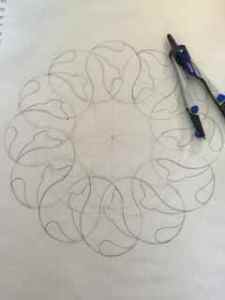 Day one began by meeting up with my fellow students for the week; people had travelled from far and wide to take part in the course (Saudi Arabia, Canada, Egypt, Turkey, America and UK) and were from a whole host of backgrounds including the total beginner, the seasoned participant, professional artists and students. But whatever the experience it didn’t seem to matter as we were expertly taken through the process of geometric drawing step by step. Following a slide lecture we began with the‘Creation Diagram’ followed by an ‘Islimi’ class in the courtyard of the Blue Mosque. How could it get better than this for soaking up the atmosphere and cultural references!
Day one began by meeting up with my fellow students for the week; people had travelled from far and wide to take part in the course (Saudi Arabia, Canada, Egypt, Turkey, America and UK) and were from a whole host of backgrounds including the total beginner, the seasoned participant, professional artists and students. But whatever the experience it didn’t seem to matter as we were expertly taken through the process of geometric drawing step by step. Following a slide lecture we began with the‘Creation Diagram’ followed by an ‘Islimi’ class in the courtyard of the Blue Mosque. How could it get better than this for soaking up the atmosphere and cultural references!
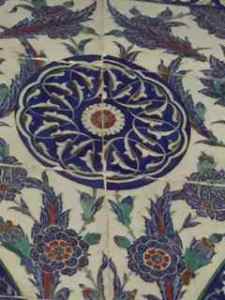
Day two continued with more biomorphic design which, surprisingly, always starts with a geometric grid! We learnt how to draw key structural elements including the ‘Rumi’ and the ‘Kepela’ and then there was the excitement of identifying these shapes inside the mosques. The intimacy of Sokulla Mehmet Pasha mosque was followed by a walk through the winding streets of the bazaar, past the rich aroma of coffee and spice stalls, to the Rustem Pascha with its 80 different tiled pattens. Here we had another ‘al fresco’ Islimi class and a study of the amazingly beautiful Iznik patterns.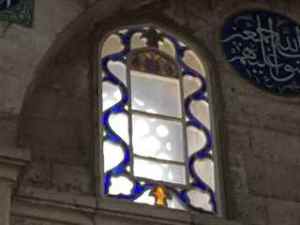
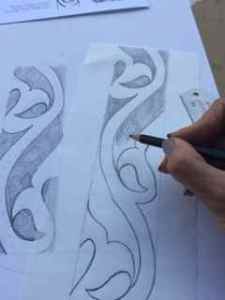
Day three: Time was going quickly so before morning class started I managed to fit in a flying visit to the Bascilla Cisterns, an amazing underground water storage system, as well as a whizz round the Turkish and Islamic Arts Museum. This was followed by more complex geometric patterns including 6 and 12 fold symmetry and then a biomorphic composition based on a Rumi pattern in one of the stained glass windows in the Suleymaniye mosque. For me, the geometry really began to come alive when I started to identify shapes and techniques within the mosques themselves.
Day four and the final morning of geometric drawing was with more complex 10 fold rosette symmetry. It was interesting how techniques learnt earlier in the week began to feel like second nature as my mind and hand were able to take on board more complex designs.
The course was rounded off with an Erbu marbling seminar and demonstration with Master craftsman Alpersian Babaoglu. There was more to marbling than I had anticipated (his restoration work for example was incredible!) and the session led to interesting discussions about the aims Eastern artists.
Overall, the week in Istanbul was fantastic. I couldn’t have learnt geometric drawing anywhere better than Istanbul and to have technique and culture in one place brought a whole new dimension to the experience. I have come away with skills and knowledge that I didn’t have before I went and am now looking forward to seeing how this new knowledge feeds into my studio practice.
Watch this space!

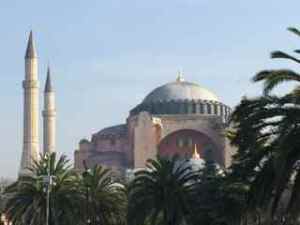
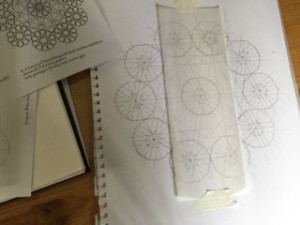

0 Comments